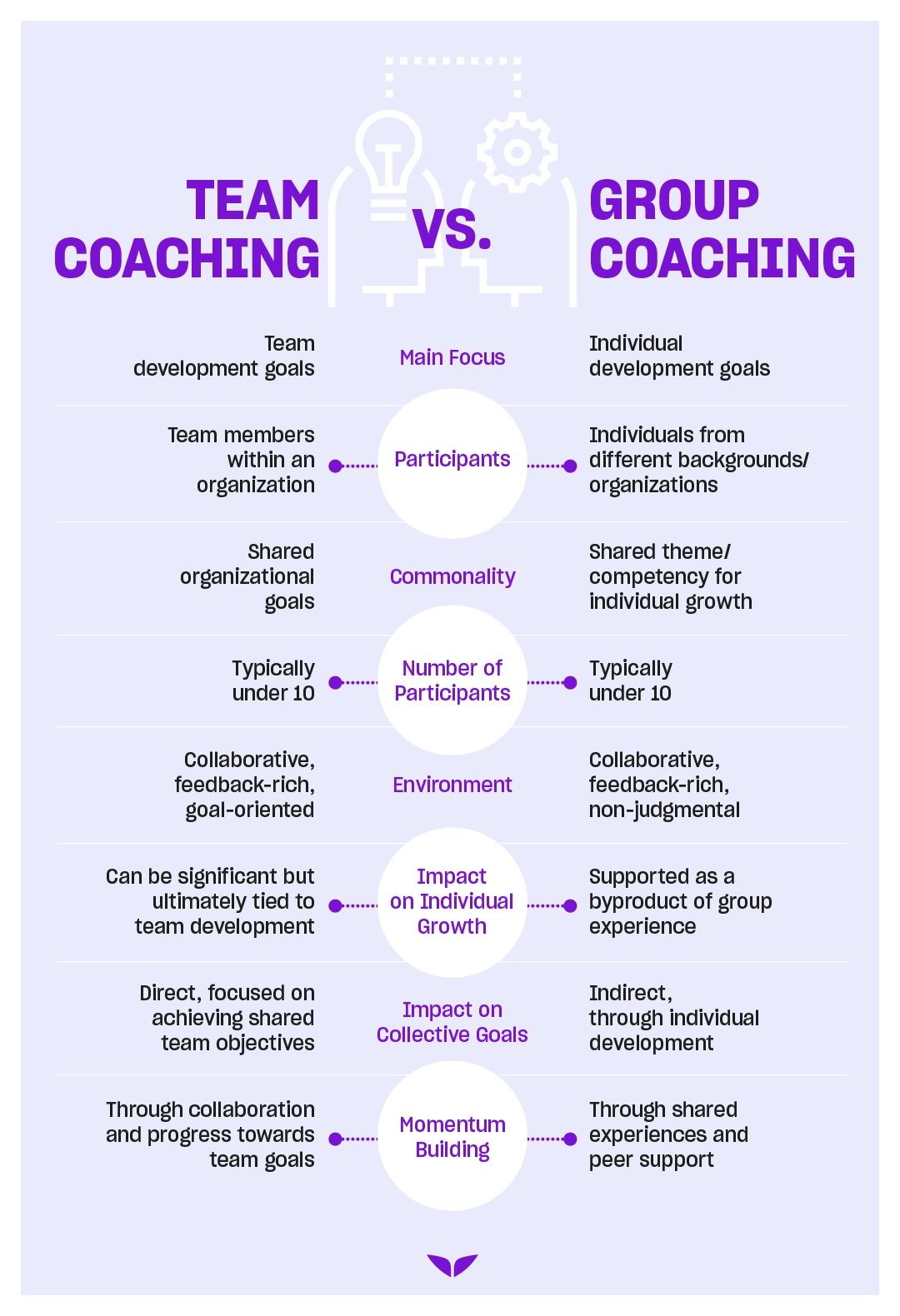Team coaching and group coaching are often confused with each other because they both relate to groups of people and are often used in organizational settings. However, there are some key differences that set these two methods apart.
Let’s explore what they are and how you can use them in your practice.
What is team coaching?
Team coaching specifically targets intact teams within organizations that work together on a regular basis. It aims to improve the collective performance, collaboration, and effectiveness of the team as a whole. What’s more, it can create team dynamics, communication, problem-solving, and goal attainment to achieve better results.
Team can be used, for example, for coaching a sales team to hit their targets or resolving a conflict in an upper management team.
What are the benefits of team coaching?
Coaching a team within an organization can have several benefits. Studies have shown that organizations with teams that are coached have a culture that is 36% more collaborative. They also had 32% less turnover and an 18% improvement in their bottom line.
Additionally, team coaching may help to:
- Align toward common goals.
- Develop an inspiring vision.
- Build healthy team relationships with clearly defined roles.
- Take responsibility for actions and results.
- Make constructive decisions in line with their organization’s goals.
How does team coaching work?
A team is a group of people who come together for a common purpose, ideally with clearly defined roles and objectives. They’re generally expected to achieve more than any individual on their own.
However, they can struggle or fail when they’re stuck in unhelpful patterns and unresolved conflicts that hinder team performance.
Coaching can help with:
- Assessment. This can make performance and KPIs measurable. It also identifies individual as well as group strengths and areas for improvement.
- Goal setting. Based on the assessment findings, the coach collaborates with the team leader to set clear goals and targets.
- Coaching sessions. These sessions may focus on improving certain skills, resolving conflict, or instilling new team values.
- Reflection and feedback. The coach may facilitate reflection exercises and guide team members to give constructive feedback to each other.
Executive team coaching and talent development on various levels of an organization are especially useful when:
- A team merges.
- A new manager takes over the team.
- Team conflicts need to be addressed.
- Team efficiency needs to be increased.
- Long projects lead to burnout.
- Conflict or stress reduces productivity.
- The team is not meeting its goals.
- Commitment is low.
- There is a major organizational change.
- Embarking on new and challenging projects.
What is group coaching?
Group coaching is a collaborative and structured process where a coach works with multiple individuals at the same time to achieve their personal or professional goals. In these sessions, participants benefit from shared experiences, peer support, and collective accountability, often resulting in accelerated growth and transformation.
The benefits of group coaching
Group coaching can prove more effective than one-on-one coaching in many situations. Here’s why:
1. Promotes problem-solving among members
This type of coaching is great for solving problems collectively. Why? Because it encourages group members to clarify challenges, identify solutions, and define action steps together. Individuals from all walks of life (or with different professional backgrounds can share their knowledge and contribute unique perspectives.
2. Guarantees transfer of training
Group coaching fosters support and accountability. It can ensure that everyone in the group applies the training content and completes their assigned exercises.
3. Fosters a learning environment
The close engagement among members and their strong focus on helping each other can quickly form a close and confidential bond. This connection allows members to rely on each other to achieve their individual goals.
4. Creates opportunities for networking
Members of a coaching group share more than just business cards when they collaborate. They discuss their personal experiences or viewpoints, give each other open and honest feedback, and share useful resources.
5. Helps them acquire core coaching skills
Cultural changes within an organization require each employee or community member to change their behavior. Group coaching can be a catalyst for that.
It creates an environment where members coach each other and cultivate cultural changes on a smaller level first. These new values and behaviors can then ripple out into the organization as a whole.
6. Creates a trusting environment beyond the group
People who undergo this type of coaching apply what they learn to their work and daily lives. They develop openness and honest communication in their relationships, making sure everyone around them feels seen, heard, and respected.
Team coaching vs. group coaching
Here’s a closer look at team coaching vs. group coaching:

Similarities between group coaching and team coaching
Let’s take a look at some of the common features that group and team coaching share:
- In both cases, individuals strive to improve their skills and performances.
- It involves multiple participants, but usually not more than 10.
- It’s designed to create a collaborative environment where feedback can be shared, and questions can be answered.
- It’s not focused on one person. However, it may also include drilling down to a specific individual when all members benefit from the group-sharing experience.
- It may support individual growth while also advancing the collective mission and goals through the coaching process.
- It helps group members build momentum while working with others.
Team coaching methodologies
Coaching teams involves techniques and methods that take into account group dynamics and areas like communication, collaboration, and culture.
Perhaps the best-known example of this is Hawkins’ five disciplines of team coaching. This business coaching method proposes a multidisciplinary approach to developing teams and emphasizes five key elements for success.
In this framework, coaches support teams with:
- Commissioning. Helping teams establish a clear purpose, success criteria, and collaborative opportunities.
- Clarity. Supporting them in clarifying their purpose, goals, values, roles, and expectations.
- Co-creation. Creating a collective awareness of team dynamics and performance.
- Linking. Coaching them to work together effectively to achieve their common goals.
- Core learning. Enabling the group to develop, adapt, and support themselves within the organizational and wider business environment.
By developing these skills, coaches enable teams to create sustainable environments for high performance, creativity, and effectiveness.
Group coaching methodologies
Group coaching programs can perform one of three functions for their members: education, training, or support.
Groups cannot be expected to work well from the start. Forming a group is like cultivating a relationship. It takes time, patience, support, and effort. Members often go through recognizable stages in the process of transforming from a gathering of strangers to a unified group with shared goals.
Adapting Bruce Tuckman’s model of group development, let’s look at group coaching as a five-step process.
1. Orientation (formation phase)
The first phase of group development is the formation phase. It represents the time when the group comes together for the first time and may feel fear and uncertainty.
The members act modestly because they want to be accepted by all members of the group. Conflicts, disputes, misunderstandings, and personal opinions are avoided—even as members begin to form impressions of each other and understand what the group does together.
The important thing here is to understand the group’s purpose, determine how the team is organized, who is responsible for what, and discuss the major milestones or phases of the group’s goals.
During this phase, group coaches provide an overview of group rules, including meeting times and available resources. Meanwhile, group members learn their roles, how the group operates, what is expected of them, and what is acceptable.
2. Power struggle (charge phase)
The second phase of group development is the charge phase, also known as the storming phase. Arguments and competition are often at their maximum as group members develop an initial sense of belonging to the group. More aggressive group members emerge, while less confrontational members stay in their comfort zones.
Questions about leadership, authority, rules, policies, norms, responsibilities, metrics, and reward systems typically arise here. These questions need to be answered for the group to move on to the next stage.
3. Collaboration and integration (normalization phase)
During this phase, the group becomes more fun and enjoyable. Group interactions are much easier, more collaborative, and more productive with balanced give-and-take, open communication, bonding, and mutual respect.
If there is a dispute or roadblock, it can be resolved relatively easily, and the group can get back on track. Group leadership is very important, but the coach can step back and let the group members take the lead and move forward together.
4. Synergies (implementation phase)
Once the group has identified its needs, the standardization phase can be reached. This is the time when the group truly comes together.
At this stage, morale is high as group members actively recognize the talents, skills, and experience each member brings to the group. A sense of deeper belonging is created, and the group remains focused on its shared purpose and goals.
Members are flexible, interdependent, and trusting. Leadership is distributed, allowing individuals to make key decisions in their own domains.
5. Closure (deferred stage)
This stage of the group is usually reached when members no longer need the coach to support them and begin to work independently.
Scale your business coaching practice with proven methods
While both group and team coaching work towards better group dynamics, they have their own methodologies and purposes.
However, there’s a foolproof process that works for any business coach, no matter their niche. Discover the ultimate formula for delivering breakthrough results to your business clients in the free Become a Mindvalley Certified Business Coach masterclass.
Welcome in.








